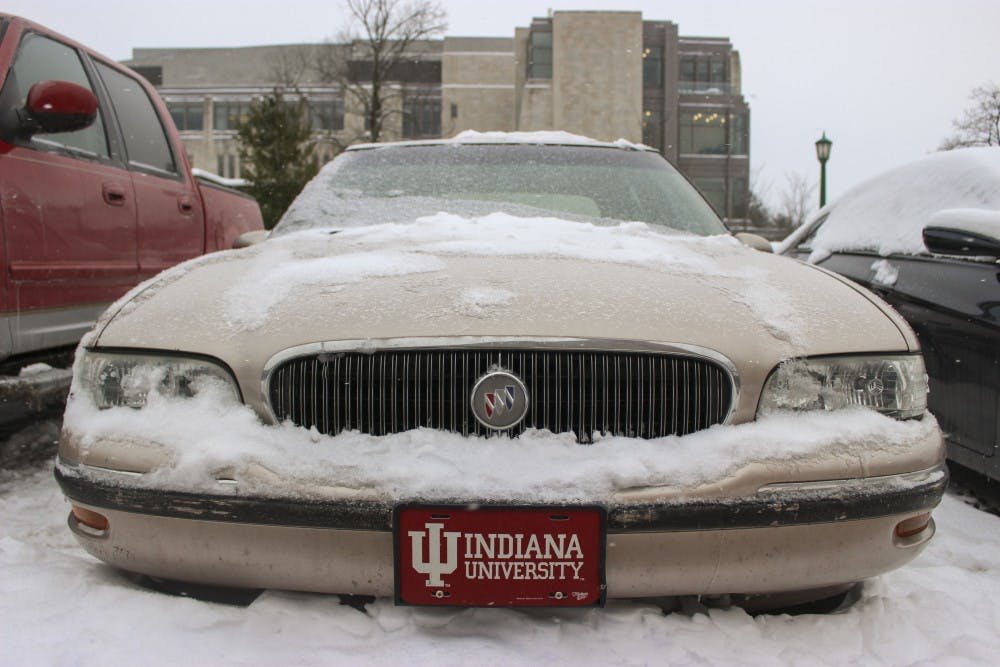When she found a note tucked under the windshield wiper of her car, a tan 90s Buick she calls Carl, IU student Meghan Halaburda thought it was a parking ticket. But when she picked it up, she said she realized the note was from two filmmakers asking to use her car in their film.
Halaburda said she then got in touch with the filmmakers, and after verifying that they were indeed local filmmakers and not professional car thieves, she agreed for her car to be used in the film.
“I’m so excited — my car is more successful than I am at this point in my life,” Halaburda said. "Hopefully this is just his big break, and he continues getting opportunities like this."
She added that the filmmakers agreed to credit her car as “Carl” in the film’s credits.
The film, an upcoming LGBT-themed film entitled “Hoosier,” has been in development for several years and will feature scenes shot in Bloomington.
“Hoosier” is still months away from completion, but writer and director Aaron Cook said he hopes to have the project finished by the end of June.
Jason Fruits, a producer and unit production manager of the film, said another producer happened to find the car while it was parked near the Airbnb that the film’s crew had been using as a home base while they were shooting in Bloomington.
Fruits said the filmmakers previously had a car lined up to use — the same model as Halaburda’s — but that it unexpectedly broke down shortly before it was needed. This car trouble prompted them to reach out to Halaburda, which landed Carl the role in the film.
Fruits, a masters student at IU studying media, got involved with “Hoosier” through IU professor Craig Erpelding. He said that he was first sold on the film by a specific line of dialogue — “Hoosiers never die” — from an early draft of the screenplay, which he said really resonated with him.
He also described the film’s production as incredible. Fruits said he was especially pleased with the camaraderie between members of the production crew.
Many members of the film’s production team were IU students.
“It was one of the most professional shoots, and it really set the bar for my own work at IU,” Fruits said.
Fruits also said the film was a sort of post-coming-out narrative.
“It’s about what it’s like to accept an identity, to move into an identity that people don’t accept,” Fruits said. “To put that onscreen is really moving.”
He also said the film focused more on its characters’ immersion into the LGBT community than their first interactions with it. It’s not a film of firsts or of coming out so much as one of progression and growth for its characters, he said.
Cook explained these ideas as part of an attempt to steer clear of the tropes of mainstream LGBT cinema, which he said he feels favors coming-out narratives for its characters far too frequently. Cook said that in his film he wanted to explore something more substantive than coming out, something deeper.
“It was important for me to try to pull away from the film just being about the moment of coming out,” he said. “It was important for me to deal with a character who had already come to terms with their sexuality.”
Cook said he had been developing the screenplay for three years before beginning production. He added that the inception of the idea for the film came when he first came out as queer.
“The one thing that sort of catapulted it off was knowing that I wanted to do something with Indiana, drawing in family history and personal history, and then knowing that I wanted to explore a queer narrative with it,” Cook said.
He also touched on the importance of queer authorship in LGBT-themed art, which he said was on his mind throughout his work on the film.
Cook also said he wanted his film to explore nontraditional expressions of gender and sexuality. He noted that many mainstream queer films — including recent standouts like “Moonlight” and “Call Me by Your Name” — typically feature straight or straight-passing, traditionally masculine men. In response to this, he said that he thought it was important to portray male femininity as valid.
“Often when you’re dealing with gay characters in movies, you often get very straight-presenting, masculine, very attractive, typically white actors,” he said. “Putting that on screen is a sort of consequence of this idea, I think, that femininity speaks to weakness.”
He added that it was also very important to him to cast queer people in queer roles.
“You get these wide release queer films that are often not by a queer filmmaker, or that star straight actors," Cook said. "Those details are really important."
Cook said his film follows a young man who has recently come out and already accepted his sexuality as he begins to immerse himself within the LGBT community as a whole. The film is not Cook’s first, but he said it’s certainly his longest and what he considers to be his most ambitious.
He said that it was important to him to try to translate a new and underrepresented part of the queer experience into film.
"What really inspired the film was that, even after coming out to friends and family, there was this whole experience of figuring out how to shed the closet," Cook said.




